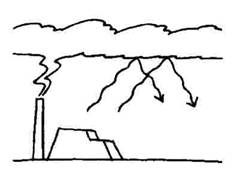Global warming
An environmental consequence of food production, which has gained much attention, is the climate changes in terms of global warming. These days global warming is debated worldwide, due to the fact that the global climate is affected by greenhouse gasses (GHG) such as CO2, methane, laughing gas etc, which are produced in different levels in the different chains of food production.
Figure 2. The greenhouse effect results |
The atmosphere absorbs some of the heat radiation from the sun and the thermal radiation is re-radiated in all directions (Figure 2). Since part of this re-radiation is back towards the surface, energy is transferred to the surface and the lower atmosphere. As a result, the temperature there is higher than it would be if direct heating by solar radiation were the only warming mechanism. In addition to the higher temperatures, the consequences are sudden regional changes in weather, extreme weather conditions, melting of ice, increased water level etc. The impact categories 'global warming' is mainly influenced by the greenhouse gases CO2, CH4and N2O. The global warming potential (GWP) is commonly expressed in CO2 equivalents. This is done to account for the fact that the different greenhouse gases have different potentials (IPCC, 2007) (Table 1). The carbon food print of a typical Danish diet is estimated in Figure 3 below. |
Table 1. Equivalent factors for GWP
| 1 kg carbon dioxide (CO2) | 1 kg CO2-eq. |
| 1 kg methane (CH4) | 25 kg CO2-eq. |
| 1 kg laughing gas (N2O) | 298 kg CO2-eq. |
